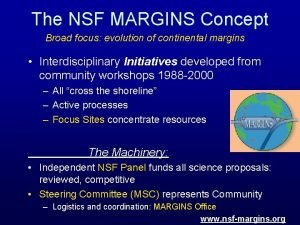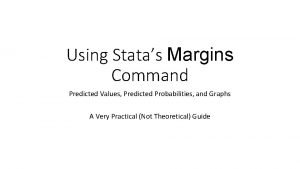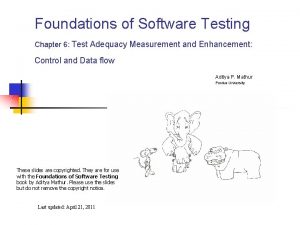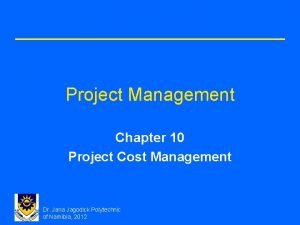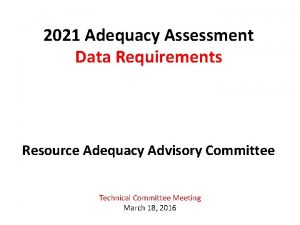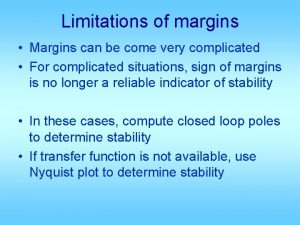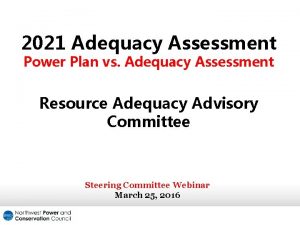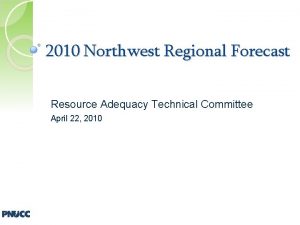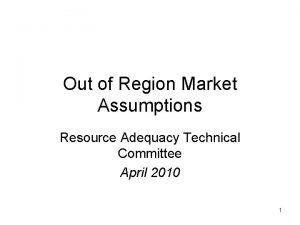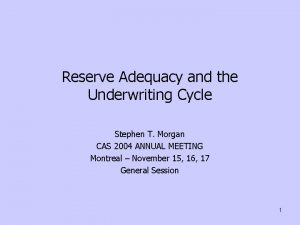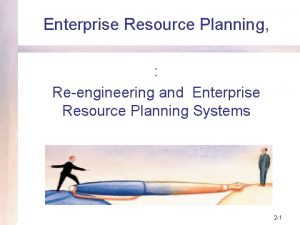Resource Adequacy and Planning Reserve Margins Technical Conference
































- Slides: 32

Resource Adequacy and Planning Reserve Margins Technical Conference on Capacity Planning and Resource Adequacy Montana Public Service Commission Helena, Montana June 8, 2017 Arne Olson, Partner

Energy and Environmental Economics, Inc. (E 3) Fast-growing consultancy based in San Francisco Rigorous analysis on a wide range of energy issues for utilities, regulators, government agencies, power producers, technology companies, and investors throughout North America and around the world • Resource planning & procurement, asset valuation, cost of service & rate design, DER cost-effectiveness, energy storage analysis, renewable integration, transmission planning, deep decarbonization pathways Our experience has placed us at the nexus of planning, policy and markets 2

INTRODUCTION: WHAT IS CAPACITY AND WHO IS RESPONSIBLE FOR IT?

What is “capacity” and why is it important? Capacity is the ability to generate electric energy at any given point in time Utilities need adequate generation capacity to meet continuously-varying electric loads reliably over a broad range of conditions The consequence of inadequate capacity is loss of load • Loss of load is inconvenient, expensive, and potentially life -threatening Utilities plan their systems to ensure that loss of load occurs very rarely Source: http: //www. energy. siemens. com 4

Planning vs. operating reliability Operating reliability Planning Reliability • Purpose: avoid cascading outages • Purpose: ensure sufficient capacity to meet load • Utility function: Balancing Area operations • Utility function: resource planning and procurement • Governed by: NERC and WECC • Governed by: state and local authorities • Standards: NERC Control Performance Standards (CPS) and Balancing Authority Ace Limit (BAAL) • Standards: Planning Reserve Margin or Loss-of. Load standard (e. g. , 1 day in 10 years) • Products needed: Operating reserves (regulation, freq. response, spin, & non-spin) • Products needed: generation capacity, dispatchable loads Today’s topic 5

“Pure capacity” vs. “Flexible capacity” “Pure capacity” is the capacity needed to meet loads under all possible conditions, subject to acceptable reliability standards • Pure capacity can be standardized and denominated in Effective MW • Effective MW is often lower than Nameplate MW • All Effective MW are the same Today’s topic • An analytical process is needed to determine an Effective MW rating for each resource “Flexible capacity” does not have a standard definition and is not a Resource Adequacy issue • There are many attributes that contribute to power system flexibility: ramp rate, start time, min up/down time • All resources are flexible to varying degrees 6

Who is responsible for ensuring adequate capacity? FERC? • Resource planning and procurement is state-jurisdictional • Some states have opted to participate in organized wholesale electricity markets with FERC-jurisdictional capacity markets NERC? WECC? • NERC and WECC develop operating standards aimed at ensuring operational reliability • NERC publishes information on resource adequacy planning but does not have mandatory planning standards Utilities, state commissions and local governing bodies • Utilities and their regulators are ultimately responsible for ensuring resource adequacy in their jurisdictions 7

Why is resource adequacy important now? Resumption of load growth and retirements of large power stations are creating the need to invest in new capacity • Wave of construction after 2000 -2001 energy crisis, combined with 2008 recession, created significant regional capacity surpluses • Utilities frequently identified “Market Purchases” as a resource in IRPs • Northwest Power and Conservation Council now estimates regional capacity shortfall in 2021 • Utilities are now identifying new capacity in IRPs • Northwestern Energy: 400 MW of new gas-fired capacity • Portland General Electric: 775 -950 MW of new capacity • Arizona Public Service: 5400 MW of new gas-fired capacity 8

Why don’t wholesale markets build capacity on their own? Wholesale markets facilitate more efficient operations and exchange of surplus energy Western Interconnection is still dominated by vertically-integrated utility systems, in which new capacity is backstopped by captive ratepayers • Developed by utilities as rate-based asset or procured from third parties via long-term PPA Even “organized markets” in regions with retail competition have required “bolt-on” capacity auctions to incent new construction • ERCOT is lone exception 9

METHODS AND PRACTICES FOR DETERMINING PRM

How do utilities ensure that they have adequate capacity? Utilities calculate a Planning Reserve Margin (PRM) to account for operating reserves, extreme weather, generation outages • PRM = % above 1 -in-2 (average year) peak load • Typical range is 12 -20% • PRM used as an entry in load-resource table for determining resource need Example Load-Resource Table Unit Natural Gas Colstrip Hydro Projects Mid-C Hydro Agreements Other Contracts DSM Renewables Imports Total Available Dependable Capacity 1 -in-2 Peak Load Planning Reserve Margin Total Dependable Capacity Needed Dependable Capacity Shortage PRM (%) MW 1, 809 296 575 123 9 126 127 92 3, 157 3, 525 550 4, 075 918 15. 6% Source: Portland General Electric, August 2015 11

How do utilities determine the right Planning Reserve Margin? PRM is a simple concept, however calculations can be quite detailed Practices for calculating a PRM are widely varied across the industry. Some examples include: 1. PRM of 15% based on its common use across the industry 2. Rule of thumb: 6% for operating reserves + 3% forced outages + 3% for more extreme weather 3. PRM based on largest single generator or transmission outage 4. PRM based on detailed loss-of-load probability (LOLP) study 12

Industry “best practice”: reliability study based on LOLP Evaluate possible load and resource conditions over thousands of simulated years to determine resources needed to meet defined reliability target • Reliability target is typically defined as “ 1 day in 10 years”, though again there is no industry standard • Reliability is modeled using Loss-of-Load Probability (LOLP) modeling techniques Definition of reliability metrics: • Loss of Load Probability (LOLP): Prob. shortfall in a given hour • Loss of Load Expectation (LOLE): Expected hours of capacity shortfall over a year, sum of LOLP across the entire year • Expected Unserved Energy (EUE): Expected load not served over a year, sum of LOLP x MW shortfall across the entire year • Effective Load-Carrying Capability (ELCC): Quantity of additional load that can be served by variable resources while maintaining reliability 13

Conventional generators are not 100% reliable LOLP analysis calculates a distribution of conventional generation availability based on forced outage rates • Generator 1 = On (P=95%) or Off (P=5%) • Generator 2 = On (P=97%) or Off (P=3%) • Etc. Distribution represents probability that the portfolio has a given quantity of available capacity Distribution is wider, and required PRM is higher, if: • System has few generators Probability Available Thermal Generation (MW) • Resources have higher outage rates 14

Loss of load occurs when available generation is less than load Loads also vary significantly due to weather Load is most likely to exceed generation during hours with high load, high generator outages, or both Generation distribution Load Generation Load > Generation LOLP 15

“Heatmap” shows when loss of load occurs on a given system Chart shows hours of LOLP by month/hour timeslice Sum of time slices is test year LOLE HE PST Month Source: Portland General Electric, August 2015 16

Planning criteria used by utilities are widely varied Peak Demand in 2021 Planning Criterion PRM Peak Season (MW) Puget Sound Energy 7, 000 MW LOLP: 5%* 16% (2023 - 2024) Winter Summer: 1, 700 MW; 22% (14% + Avista LOLP: 5%* Both Winter: 1, 900 MW operating reserves) Pacifi. Corp 10, 876 MW LOLE: 2. 4 hrs/ year 13% Summer Arizona Public Service 9, 071 MW One Event in 10 Years 15% Summer Tuscon Electric Power 2, 696 MW PRM 15% Summer Greater of 13% or Public Service Co. of New Mexico 2, 100 MW LOLE: 2. 4 hrs/ year Summer 250 MW El Paso Electric 2, 000 MW PRM 15% Summer Cleco 3, 000 MW LOLE = 1 -day-in-10 yrs. 14. 8% Summer Kansas City Power & Light 483 MW Share of SPP** 12%** Summer Oklahoma Gas & Electric 5, 500 MW Share of SPP** 12%** Summer South Carolina Electric & Gas 5, 400 MW 24 to 2. 4 days/10 yrs 14 -20% Both Tampa Electric 4, 200 MW PRM 20% Both Interstate Power & Light 3, 300 MW PRM 7. 3% Summer Florida Power and Light 24, 000 MW PRM 20% Both California ISO 52, 000 MW LOLE: 0. 6 hours/year 15 -17% Summer * PSE and Avista use NWPCC criterion of 5% probability of shortfall occurring any time in a given year ** SPP uses 1 -day-in-10 years or 12% PRM system-wide 17

RENEWABLES AND FLEXIBLE CAPACITY

Renewable resources contribute to resource adequacy No resource is perfectly available to help reduce LOLP By convention, dispatchable resources rated at nameplate and forced outages factored into PRM Non-dispatchable resources assigned “effective capacity” rating Illustrative Capacity Values 95 MW Capacity Value 60 MW Capacity Value 100 MW nameplate 20 MW Capacity Value Fossil Generation Wind Generation Solar Generation 19

Methods for estimating capacity credit of renewables Heuristic approximations • Time window methods • Average or percentile capacity factor during highest load hours • Currently the most common industry method due to ease of calculation • Simple and easy to understand but increasingly inaccurate at high penetrations Reliability based methods • Effective Load Carrying Capability (ELCC) • After new variable generation is added to a system, ELCC is defined as the additional load that can be added to the system while still maintaining the original system reliability (original annual LOLE) Accurately measuring the contribution of renewable energy becomes increasingly important as its share of system capacity grows! • Accurate but computationally intensive 20

Methods for estimating capacity credit of renewables vary widely Approach Notes BPA California PUC Idaho Power ISO New England New York ISO Time window Time-window Ontario IESO Time-window PJM PNM Time-window Wind is assigned zero value Dec-Mar, 4 -9 pm, Apr-Oct, 1 -6 pm Summer, 3 -7 pm Jun-Sep, 2 -6 pm Jun-Aug, 2 -6 pm, Dec-Feb, 4 -8 pm Capacity factor over the top 5 contiguous daily peak demand hours Jun-Aug, 4 -6 pm Peak hour Monte Carlo analysis supplemented by analysis of fourteen critical extreme cold weather events Average capacity value over several years of LOLE simulations Based on 10 -year ELCC study Quebec Balancing Authority Area Other Arizona Public Service ELCC BC Hydro ERCOT Midwest ISO PSCO/Xcel ELCC 21

Effective Load-Carrying Capability Adding renewables reduces LOLE due to expectation of non-zero production Adding load returns system to the original LOLE The amount of load that can be added to the system is the Effective Load-Carrying Capability (ELCC) of the renewables Original system LOLE after renewables Additional load to return to original system LOLE = ELCC 22

ELCC method: Subtract renewables from load in LOLP calculations Renewable production is subtracted from gross load to yield “net load”, which is always lower LOLP decreases in every hour Net thermal generation distribution Net load Gross load distribution with renewables Gross load Renewable net load Thermal generation Reduction in LOLP with increase in renewables 23

Factors that affect the capacity value of variable generation Coincidence with load August Weekday, HE 17 • Resources with better correlation with high load periods have higher ELCC Coincidence with existing portfolio • Adding more capacity of the same type results in lower marginal value • Adding diversity results in higher marginal value Variability • Statistically, the possibility of low production during a peak load event reduces the value of a resource 24

How is “Flexible Capacity” related to Resource Adequacy? Under flexibility-constrained operations, reliability can be maintained through renewable dispatch, at the cost of lost production 1. Without renewable dispatch: shedding of firm load required Strategy to Minimize Downward Violations 2. With renewable dispatch: no load shedding required Strategy to Minimize Upward Violations Unserved Energy Limited Ramping Capability Renewable Curtailment Capacity does not need to be “flexible” for Resource Adequacy purposes, but flexibility does help with operations & curtailment. Key question: how much to pay for additional flexibility? 25

ROLE OF REGIONAL MARKET

Interactions with the regional market Conventional methods effectively assume that each system is an island • Long-term contracted resources treated as owned • Generic imports can be represented as a resource, perhaps with transmission outage rate Many utilities rely on “market purchases” to fill energy and capacity gaps • Based on assumed availability of resources • Regional market conditions typically not analyzed rigorously • How much capacity can a utility count on being able to acquire from its neighbors? 27

Are current practices sufficient to maintain reliability? Current practices rely on 16 states & provinces and many local jurisdictions to adopt practices that maintain reliability across our multi-state regional grid Current system can work as long as: • Every utility calculates its own needs in a sufficiently robust manner • Every utility builds or identifies physical resources to meet its own needs • New resource additions are approved in a timely manner However, analysis is complex and often contentious 28

Benefits of regional planning reserve sharing Regional planning reserve sharing would take advantage of load and resource diversity that exists across regions • A system in which each utility builds physical assets to meet its own needs will result in overcapacity, because not every system peaks at the same time • Planning to meet regional coincident peak loads requires less capacity than meeting each individual utility’s peak loads • Resources that are surplus in one area could be utilized to meet a deficit in a neighboring area • Larger systems require lower reserve margins because they are less vulnerable to individual, large contingencies • Regional entity could adopt more sophisticated practices and computer models than individual utilities • Regional entity would provide calculation of capacity need that is independent from the utility 29

CONCLUSION

Key questions for regulators in assessing resource adequacy 1. How accurate or reliable is the utility’s peak load forecast? 2. How robust is the utility’s method for determining its Planning Reserve Margin? 3. How accurate is the utility’s method for estimating the capacity contribution of renewables? 4. How can the utility know how much capacity is available in the regional market? 5. How much should utility be willing to pay for flexible capacity? 31

Thank You! Energy and Environmental Economics, Inc. (E 3) 101 Montgomery Street, Suite 1600 San Francisco, CA 94104 Tel 415 -391 -5100 Web http: //www. ethree. com Arne Olson, Partner (arne@ethree. com)
 Source of capital reserve
Source of capital reserve Difference between capital reserve and reserve capital
Difference between capital reserve and reserve capital Contingency reserve vs management reserve
Contingency reserve vs management reserve Marine provinces
Marine provinces Type of plate boundary
Type of plate boundary Stata plot interaction effects
Stata plot interaction effects Convex colony
Convex colony Nsf margins
Nsf margins Mla google docs
Mla google docs What type of forces dominate at convergent plate margins
What type of forces dominate at convergent plate margins Is apa in times new roman
Is apa in times new roman Margins
Margins Continental margins
Continental margins Absorption unsharpness
Absorption unsharpness Types of leaf simple and compound
Types of leaf simple and compound Stata margins continuous categorical interaction
Stata margins continuous categorical interaction Software unit test coverage and adequacy
Software unit test coverage and adequacy Horizontal and vertical adequacy
Horizontal and vertical adequacy Condition coverage
Condition coverage Criteria of adequacy fruitfulness
Criteria of adequacy fruitfulness How to calculate crar
How to calculate crar Certificate of adequacy
Certificate of adequacy Slot filler
Slot filler Adequacy
Adequacy Adequacy
Adequacy Cash flow statement
Cash flow statement Model adequacy checking anova
Model adequacy checking anova Liability adequacy test
Liability adequacy test Resource loading vs resource leveling
Resource loading vs resource leveling Contoh resource loading
Contoh resource loading 2019 dod allied nations technical corrosion conference
2019 dod allied nations technical corrosion conference Mil-std-1587
Mil-std-1587 Resource aggregation in project management
Resource aggregation in project management







